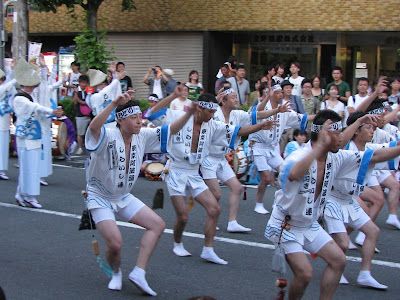Dancers preparing to start the parade
What is Awaodori?
The dance originated in Tokushima prefecture, which is in Shikoku in the far south of Japan. It's approximately 400 years old and one of the three biggest summer dances, along with Nishimonai Bon-odori (西馬音内盆踊り) from Akita prefecture and Gujou Hachiman Bon-odori (郡上八幡盆踊り) from Gifu prefecture. Bon-odori is a kind of festival dance done in summer. You often see it at various events in Japan. The Awa odori is somewhat unusual in its dance moves. It is believed to have derived from Noh theatre.
The groups of dancers are accompanied by taiko drums, shinobue flutes, shamisen, and bells. There are two types of dances: those for women and those for men. The women wear a type of dance kimono, which is very tight with distinctive hats. They dance on the tips of their geta sandals with their hands in the air. The men wear happi coats or short yukata (summer kimono), shorts, and a type of tabi sock with a thick sole. Their dance is crouched down and often performed with a fan, lantern, or uchiwa (the round fans that don't fold). Women may also perform the men's style of dance, but men do not dance the women's style.
Sounds a bit boring, but the groups don't just dance in place. The drums get rocking and the men's groups start going crazy. There was running, big jumps in the air, insane freestyle moves, etc. This event is totally worth seeing!
Here are some examples of the women and men's costumes:
Young girl wearing the traditional hat, called 鳥追笠 (torioigasa) or 編み笠 (amikasa), which is a type of sloped hat made from grass. It is sewn together and often has a lovely contrasting colour border and strap.
Woman wearing the traditional happi coat, shorts, tabi socks, obi and head towel of the men's dance. She is carrying a dance fan called 舞扇子 (maiogi), but the dance can also be done with uchiwa (round fans that do not fold) or lanterns.
Women's Dance Style:
The dancers usually start in a crouching position, awaiting the signal to start dancing. The signal is the band leader hitting a sort of cymbal that sounds like a bell. This is a good signal for you to get your camera ready, too.
The women make small, mincing steps on the tips of their geta sandals (heels do not touch the ground) and make a sort of high kick in the back.
Here you can see the height of the kick in the back. This must have been a bit scandalous dance back in the day, showing so much leg!
Here is a close up of their feet:
The men's dance is also quite difficult, as it requires the dancer to stay in a crouched position, putting all his weight on his thigh muscles (rather like doing squats at the gym), moving his right hand and foot forward, with toes pointed down. He then makes a sort of triangle movement in the air with his hands and flicks them at the wrist. The leg is crossed over and down and the movement repeats with the left hand and foot.
Although Tokushima is the origin of Awa-odori, and undoubtedly the best place to see it, not all of us can afford to go down to Shikoku, so Koenji's festival is a good alternative. It's large, boisterous, and performed on several streets around the station, so you can be guaranteed of a good view.
I recommend getting there a bit early, if you want a good view. I arrived around 4, and immediately made my way out to one of the starting points of the dance. A good place to be is just past one of the yellow arches that have 読売新聞 (Yomiuri Shinbun- a sponsor of the event) written on them. Those are the starting points for each group to dance. If you're just on the other side of it (opposite the side with writing), you'll have a fantastic view of the dancers as they come through.
Pick a spot you want to stay in, because as the festival goes on, the sidewalks fill up until they're three or four people deep. This makes it hard to move around and you may not get another good viewing spot. The farther out you are from the station, the less people will be there, so try to choose one of the locations at the end of the main street. Helpful people with pamphlets and fans (great souvenirs, as they're free!) will help guide you and give you a map.
Don't worry about bringing a snack. Street stalls are set up every foot or so along all the main streets, selling drinks and various snacks. You can get everything from Japan's favorite summer drink, Lamune, to beer and Bacardi Mojitos (you can drink alcohol on the streets of Japan, so don't worry). Food varies from traditional festival food like yakisoba and okonomiyaki to hot dogs on a stick and gyoza. I guarantee you will find something you like. There are also a plethora of convenience stores, on the off chance you don't like what the stalls have to offer.
Here are a few more shots of the festival.
For more information on the festival and more pictures, please visit Koenji City's website that is dedicated to the event. You can also find information about buying goods from the festival.
Hope to see you all there next year!


























sewa mobil jepara
ReplyDeletesewa mobil semarang
sewa bus semarang
thanks to the info from my father added insight thank you so much, may be useful for us all
please aprove mister.